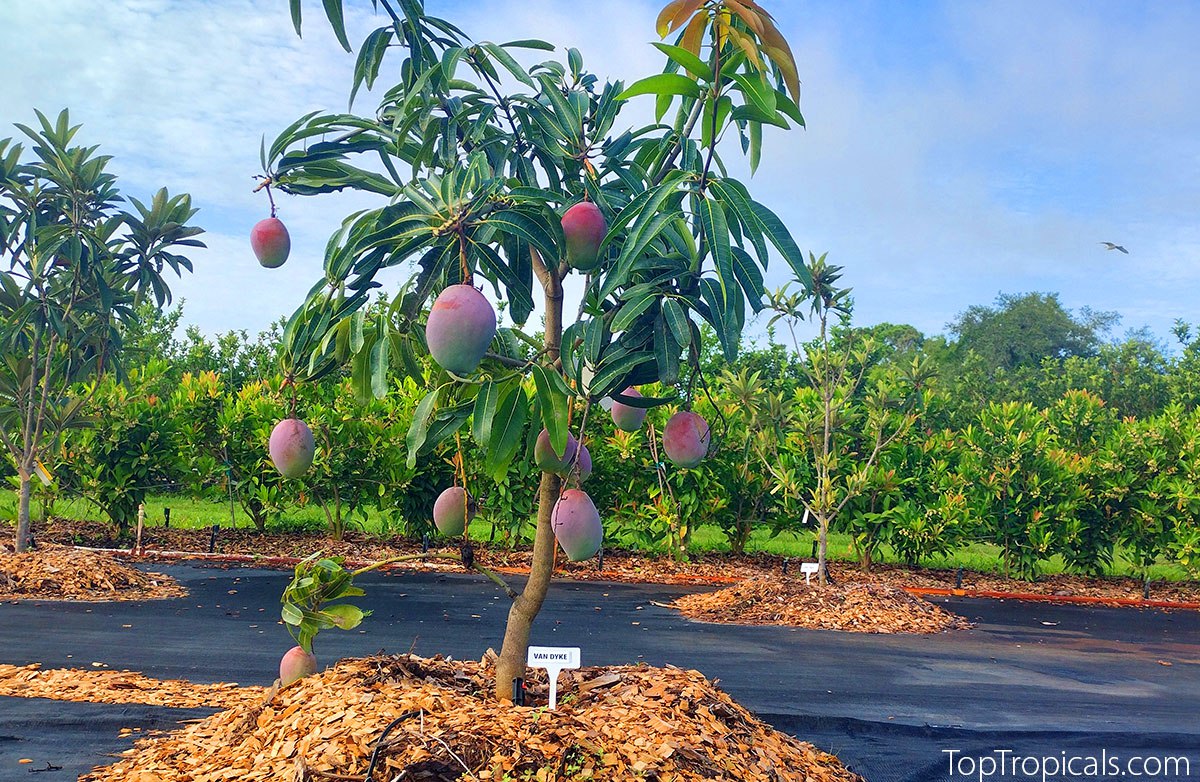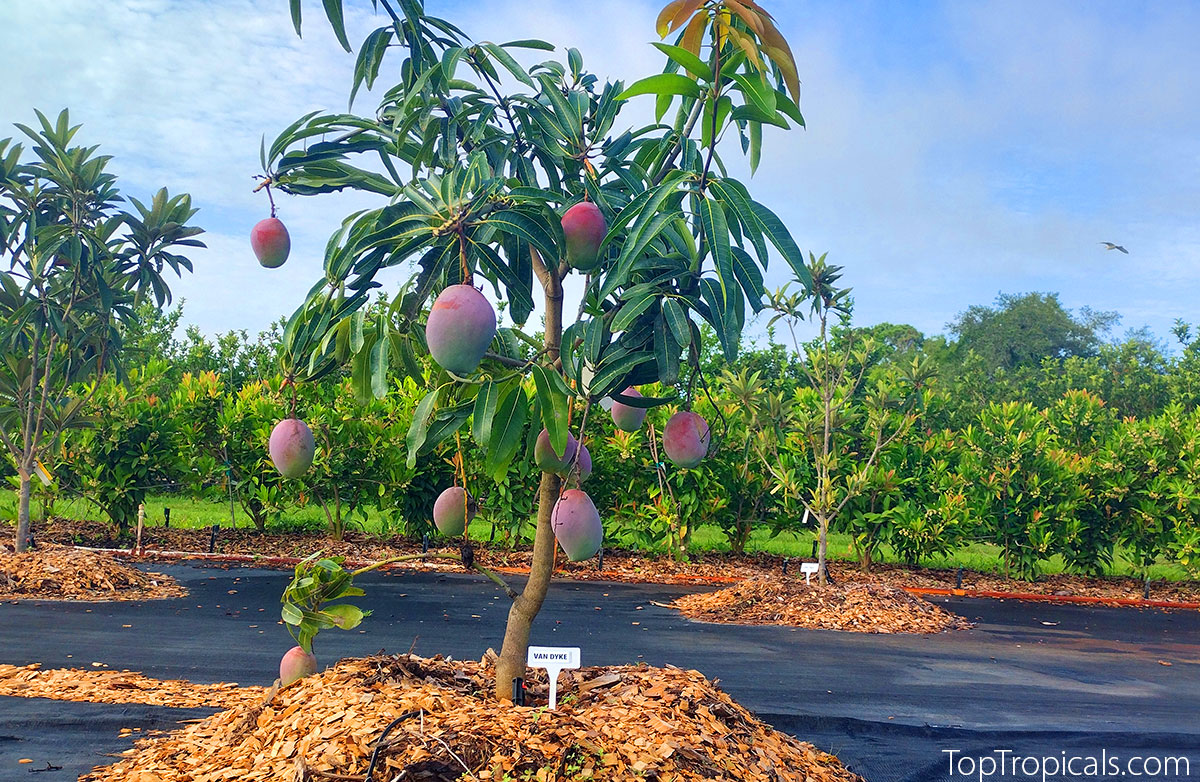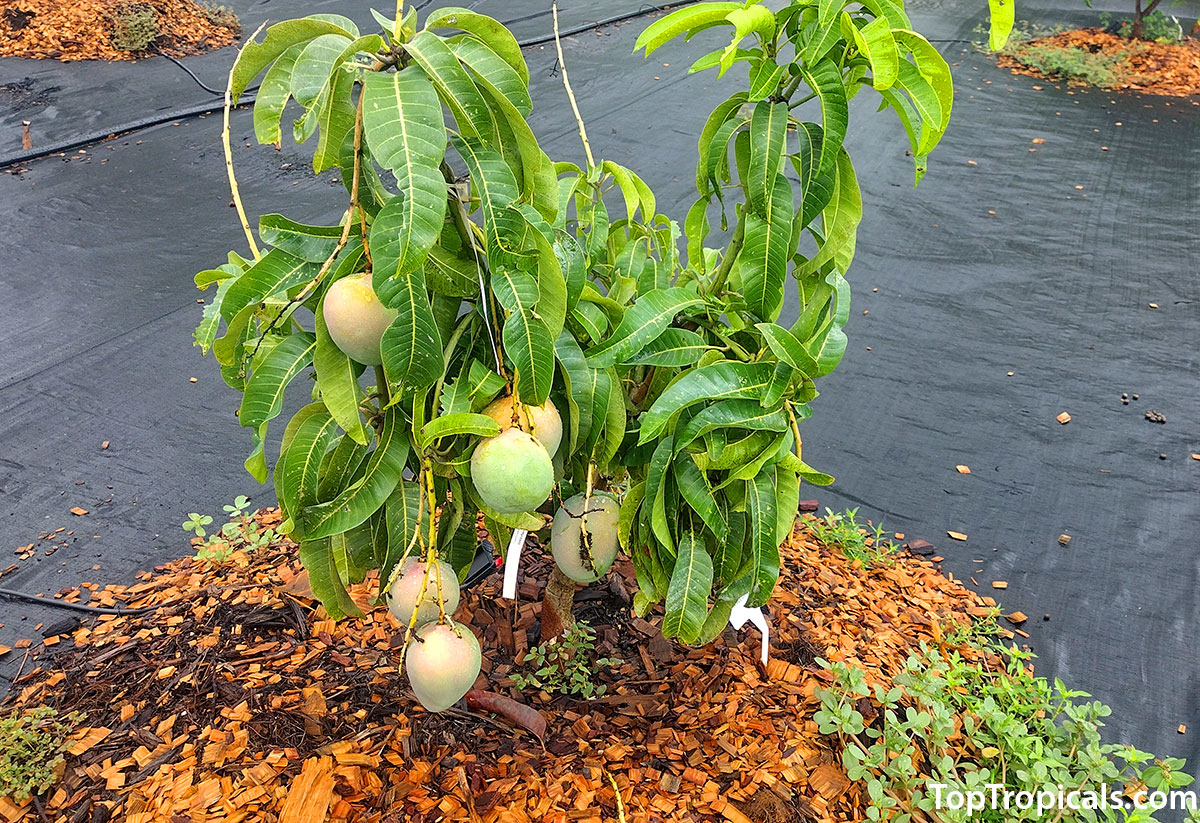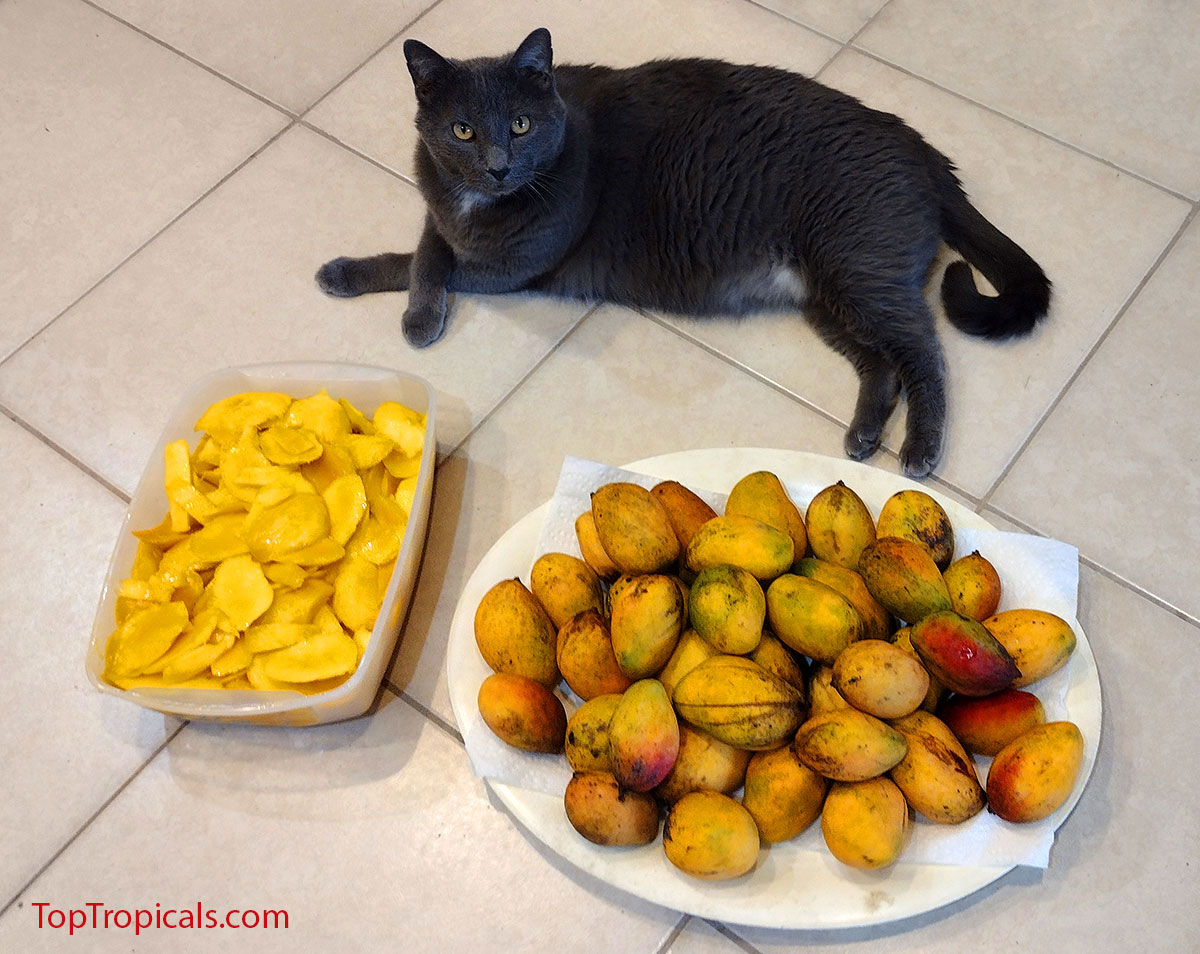Discover 10 best fruit trees to grow in Florida and Southern landscapes

Tropical fruit collage
- Mango (Mangifera indoca)
- Avocado (Persea americana)
- Tropical Cherries (Eugenia sp.)
- Barbados Cherry (Malpighia glabra)
- Noni (Morinda citrifolia)
- Macadamia Nut (Macadamia integrifolia)
- Papaya (Carica papaya)
- Guava (Psidium sp.): Cattley and Tropical guava
- Jackfruit (Artocarus heterophyllus)
- Loquat (Eriobotrya japonica)
Stay with us to learn more about these trees in the following posts and make sure to subscribe! ⬇️
📚 Learn more from previous posts:
🛒 Shop fruit trees
#Food_Forest
🔴 Join 👉 TopTropicals
How to take care of a mango tree in winter

❄️ Watering
❄️ Fertilizing
❄️ Temperature Protection
❄️ Sunlight
❄️ Check for Pests
During winter, mango trees need minimal watering. Overwatering can cause root rot, especially when temperatures are low. Water the tree only when the soil feels dry about 2 inches deep.
Avoid feeding in the winter with dry fertilizer. It may cause root burn, plus encourages new growth that is more susceptible to cold damage. Wait until spring when the weather warms up to resume heavy feeding your tree. You can continue using Sunshine Boosters natural liquid fertilizers - Sunshine Mango Tango: it is safe to apply year around since its intake is regulated by reduced water, and only the necessary amount of essential elements will be delivered.
Mango trees are sensitive to cold. If you live in a region with freezing temperatures, move your mango tree indoors or to a sheltered location like a garage with a bright light source. If it's in a small container, consider bringing it inside for the winter.
Ensure the tree gets as much sunlight as possible. If indoors, place it near a South-facing window where it can soak up the sun during the day.
Winter can bring pests indoors. Regularly inspect the tree for any signs of insect problems around the leaves and stems.
By following these guidelines, your mango tree will be healthier and better prepared for the next growing season.
📚 Learn more: Mango trees and how to deal with cold weather.
🛒 Shop Mango varieties
📝 Earlier posts on #Mango:
- 🔸 What are the Condo Mangos? A Practical Guide
- 🔸 Mango rainbow: What's the taste of that mango variety?
- 🔸 5 most Favorite Mango Varieties
- 🔸 Top 10 Dwarf "Condo" Mango
- 🔸 Top 5 vigorous growers and reliable producers
- 🔸 Top 5 exotic Mango varieties for rare fruit collection
- 🔸 How to grow a mango tree
- 🔸 How to protect mango fruit from rodents
#Food_Forest #Mango
🔴 Join 👉 TopTropicals
Date:
How to take care of a mango tree in winter
Q: I bought a mango tree for my husband for Christmas, and we are having kind of a butting of heads on how to take care of it. I personally feel that he has over-watered and over-fertilized. Any advice how to take care of a mango tree in winter?
A: We're happy to help you with your mango tree. It sounds like you're facing some common issues, and we'll guide you through the best care practices, especially for winter.
Watering.
During winter, mango trees need minimal watering. Overwatering can cause
root rot, especially when temperatures are low. Water the tree only when the
soil feels dry about 2 inches deep.
Fertilizing.
Avoid feeding in the winter with dry fertilizer. It may cause root burn,
plus encourages new growth that is more susceptible to cold damage. Wait until
spring when the weather warms up to resume heavy feeding your tree. You can
continue using Sunshine Boosters natural liquid fertilizers - Sunshine Mango Tango: it is safe to apply year around since its intake
is regulated by reduced water, and only the necessary amount of essential
elements will be delivered.
Temperature Protection.
Mango trees are sensitive to cold. If you live in a region with
freezing temperatures, move your mango tree indoors or to a sheltered location like
a garage with a bright light source. If it's in a small container, consider
bringing it inside for the winter.
Sunlight.
Ensure the tree gets as much sunlight as possible. If indoors, place it
near a South-facing window where it can soak up the sun during the day.
Check for Pests.
Winter can bring pests indoors. Regularly inspect the tree for any
signs of insect problems around the leaves and stems.
By following these guidelines, your mango tree will be healthier and better prepared for the next growing season.
Learn more: Mango trees and how to deal with cold weather.
What are the Condo Mangos?

Mango tree with fruit
- 🟠 What Are Condo Mangos?
- 🟠 The term “Condo Mango”
Condo Mangos, also known as dwarf mango trees, are perfect for small spaces. These trees can be grown in containers, making them ideal for balconies, greenhouses, or small suburban backyards. With proper care, they can be maintained at a manageable height of 6–10 feet through regular pruning. Some plant enthusiasts even manage growing Mango tree as an indoor plant!
“Condo Mango” refers to mango varieties that thrive in containers and are small by nature, allowing them to be easily kept even smaller with selective pruning.
- 🟠 Size and Growth
- 🟠 Growing in Containers
Unlike traditional mango trees, Condo Mangos are compact. They naturally grow to around 6-10 feet, but with proper pruning, they can be kept small, making them an excellent choice for limited space.
· Condo Mango trees thrive in pots and containers.
- · A 15-20 gallon pot is ideal to give the roots enough room to grow.
- · Ensure your container has drainage holes to prevent root rot.
- 🟠 Planting Tips
· Plant Condo Mangos in full sun, where they’ll get plenty of heat and light.
- · Use well-draining soil for optimal growth.
- · Fertilizer regularly with quality plant food. Out best choice is Sunshine Mango Tango for edibles.
- · Late Winter to early Spring is the best time to plant in containers, before the rainy season starts.
- · Mangoes grow well in USDA zones 9-10, but if you live in cooler climates, you can grow them indoors or in a greenhouse, as long as you meet their heat and light needs.
🟠 Pruning and Maintenance
- · Prune Condo Mango trees once a year to keep them at the desired height (6–10 feet), right after harvesting (late Summer to Fall)
- · Trim the tips of the branches to maintain a compact shape and encourage healthy growth.
- · Regular pruning will help keep the tree manageable and ensure better fruit production.
- 📝 See most popular Condo Mango varieties in the next post 👇
🛒 Shop Condo Mango
📝 Earlier posts on #Mango:
- 🔸 Mango rainbow: What's the taste of that mango variety?
- 🔸 5 most Favorite Mango Varieties
- 🔸 Top 10 Dwarf "Condo" Mango
- 🔸 Top 5 vigorous growers and reliable producers
- 🔸 Top 5 exotic Mango varieties for rare fruit collection
- 🔸 How to grow a mango tree
- 🔸 How to protect mango fruit from rodents
#Food_Forest #Mango
🔴 Join 👉 TopTropicals
Date:
Condo (Dwarf)
Mango Practical Guide:
What varieties are good for container culture
or small yards
Q: "Our winters are too cold for a mango tree, but I'd like to grow one in a pot so I can bring it inside during cold nights. Which varieties do you recommend for container gardening? I've heard of Condo Mango - do you carry them?"
A: Yes, we always carry Condo Mango varieties: they are a fantastic choice for gardeners with limited space or in cooler climates. They grow well in containers and can be easily maintained through pruning. Whether you're growing them on a balcony, in a greenhouse, or in a backyard, Condo Mangos provide the perfect mix of beauty and practicality.
What Are Condo Mangos?
Condo Mangos, also known as dwarf mango trees, are perfect for small spaces. These trees can be grown in containers, making them ideal for balconies, greenhouses, or small suburban backyards. With proper care, they can be maintained at a manageable height of 6-10 feet through regular pruning. Some plant enthusiasts even manage growing Mango tree as an indoor plant!
The term Condo Mango
Condo Mango refers to mango varieties that thrive in containers and are small by nature, allowing them to be easily kept even smaller with selective pruning.
Size and Growth
Unlike traditional mango trees, Condo Mangos are compact. They naturally grow to around 6-10 feet, but with proper pruning, they can be kept small, making them an excellent choice for limited space.
Growing in Containers
- Condo Mango trees thrive in pots and containers.
- A 15-20 gallon pot is ideal to give the roots enough room to grow.
- Ensure your container has drainage holes to prevent root rot.
Planting Tips
- Plant Condo Mangos in full sun, where they'll get plenty of heat and
light.
- Use well-draining soil for optimal growth.
- Fertilizer regularly with quality plant food. Out best choice is Sunshine Mango Tango for edibles.
- Late Winter to early Spring is the best time to plant in containers,
before the rainy season starts.
- Mangoes grow well in USDA zones 9-10, but if you live in cooler climates,
you can grow them indoors or in a greenhouse, as long as you meet their heat
and light needs.
Pruning and Maintenance
- Prune Condo Mango trees once a year to keep them at the desired height
(6-10 feet), right after harvesting (late Summer to Fall)
- Trim the tips of the branches to maintain a compact shape and encourage
healthy growth.
- Regular pruning will help keep the tree manageable and ensure better
fruit production.
Learn more: Find out what are Top 10 Dwarf Condo Mango - great for container culture.
Date:
How to care for your mango tree in winter
🥭 If you want to enjoy mangoes like ours (in the video) next summer, protecting your tree in winter is a must! Give it the care it needs now, and you'll reap sweet rewards when the warm weather returns.
🥭 Keep it cozy and protected: Mango trees love warmth, so when winter comes, they need extra care to stay happy.
🥭 Temperature: Mango trees are sensitive to cold. If temperatures drop below 35F, cover the tree with frost cloth or burlap to protect it. For potted mango trees, move them indoors or to a greenhouse.
🥭 Watering: Reduce watering during winter. Mango trees don’t like soggy roots in cold weather. Let the soil dry slightly between waterings.
🥭 Mulching: Add a thick layer of mulch around the base of the tree to insulate the roots and retain warmth. Keep the mulch a few inches away from the trunk.
🥭 No pruning: Avoid heavy pruning in winter, as it can stress the tree. Besides, pruning promotes young tender growth that may get cold damaged. Save major trimming for spring.
🥭 Feeding: Stop dry fertilizer in winter. The tree slows its growth, so too much dry fertilizer can do more harm than good. You can continue using Sunshine Boosters Mango Tango year-round because it is water-soluble and natural, and the amount of food needed will adjust with reduced watering.
🛒 Shop Mango Trees
#Food_Forest #How_to #Mango
🔴 Join 👉 TopTropicals
Date:
How to care for your mango tree in winter
Q: I bought a few mango trees from you this year, and they’re doing great! So far, winter’s been pretty mild here in Florida, but I know January and February can get chilly. Is there anything special I should do to keep my trees happy so I can enjoy fruit next year?
A: If you want to enjoy mangoes like ours (in the photo) next summer, protecting your tree in winter is a must! Give it the care it needs now, and you'll reap sweet rewards when the warm weather returns.
Keep it cozy and protected: Mango trees love warmth, so when winter comes, they need extra care to stay happy.
Temperature: Mango trees are sensitive to cold. If temperatures drop below 35F, cover the tree with frost cloth or burlap to protect it. For potted mango trees, move them indoors or to a greenhouse.
Watering: Reduce watering during winter. Mango trees don’t like soggy roots in cold weather. Let the soil dry slightly between waterings.
Mulching: Add a thick layer of mulch around the base of the tree to insulate the roots and retain warmth. Keep the mulch a few inches away from the trunk.
No pruning: Avoid heavy pruning in winter, as it can stress the tree. Besides, pruning promotes young tender growth that may get cold damaged. Save major trimming for spring.
Feeding: Stop dry fertilizer in winter. The tree slows its growth, so too much dry fertilizer can do more harm than good. You can continue using Sunshine Boosters Mango Tango year-round because it is water-soluble and natural, and the amount of food needed will adjust with reduced watering.
How to make a simple and delicious mango smoothie

✅ Ingredients:
- · 2 ripe mangoes, peeled and chopped
- · 1 cup milk (dairy or plant-based)
- · ½ cup plain yogurt (optional for creaminess)
- · 1-2 tablespoons honey or sugar (optional, to taste)
- · 1 cup ice cubes (adjust for desired thickness)
✅ Instructions:
· Add mango chunks, milk, yogurt, honey (if using), and ice cubes to a blender.- · Blend until smooth and creamy.
- · Taste and adjust sweetness if needed.
- · Pour into glasses and serve immediately.
For a tropical twist, you can add a splash of orange juice, a banana, or a pinch of cardamom. Enjoy! 🥭
🛒 Plant a Mango Tree today for a happy crop tomorrow
#Food_Forest #Recipes
🔴 Join 👉 TopTropicals









